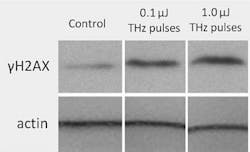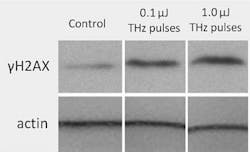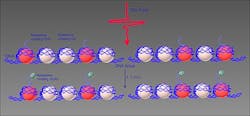Terahertz pulses cause DNA damage while inducing DNA repair
Researchers at the University of Alberta (Edmonton, AB, Canada) and the University of Lethbridge (Lethbridge, AB, Canada) have found that short but powerful bursts of terahertz radiation may both cause DNA damage and increase the production of proteins that help the body fight cancer.
Terahertz photons are not energetic enough to break the chemical bonds that bind DNA together in the nucleus of cells. But recent theoretical studies suggest that intense terahertz pulses of picosecond duration may directly affect DNA by amplifying natural vibrations of the hydrogen bonds that bind together the two strands of DNA. As a result, âbubblesâ or openings in DNA strands can form. So the researchers sought to find out whether or not intense terahertz pulses can destabilize DNA structure enough to cause DNA strand breaks.
In their study, the researchers exposed laboratory-grown human skin tissue to intense pulses of terahertz electromagnetic radiation and have detected the telltale signs of DNA damage through a chemical marker known as phosphorylated H2AX. At the same time, they observed terahertz pulse-induced increases in the levels of multiple tumor suppressor and cell-cycle regulatory proteins that facilitate DNA repair. This may suggest that DNA damage in human skin arising from intense picosecond terahertz pulse exposure could be quickly and efficiently repaired, therefore minimizing the risk of carcinogenesis.
The researchers used a skin tissue model made of normal, human-derived epidermal and dermal cells. This tissue is able to undergo mitosis (cell division) and is metabolically active, thus providing an appropriate platform for assessing the effects of exposure to high-intensity terahertz pulses on human skin. For their study, Lyubov Titova and her colleagues exposed the skin tissue to picosecond bursts of terahertz radiation at levels far above what would typically be used in current real-world applications. They then studied the sample for the presence of phosphorylated H2AX, which âflagsâ the DNA double strand break site and attracts cellular DNA repair machinery to it.
âThe increase in the amount of phosphorylated H2AX in tissues exposed to intense terahertz pulses compared to unexposed controls indicated that DNA double strand breaks were indeed induced by intense terahertz pulses,â observed Titova. Once DNA breaks occur, they can eventually lead to tumors if unrepaired. âThis process,â she continued, âis very slow and cells have evolved many effective mechanisms to recognize damage, pause cell cycle to allow time for damage to be repaired, andâin case repair is unsuccessfulâto prevent damage accumulation by inducing apoptosis, or programmed cell death of the affected cell.â
The researchers confirmed that these cellular repair mechanisms were taking place by detecting an elevated presence of multiple proteins that play vital roles in DNA repair, including protein p53 (often called âa guardian of the genomeâ); p21, which works to stop cell division to allow time for repair; protein Ku70, which helps reconnect the broken DNA strands; and several other important cell proteins with known tumor-suppressor roles. These observations indicate that exposure to intense terahertz pulses activates cellular mechanisms that repair DNA damage. However, the researchers note, it is too soon to make predictions on the long-term implications of exposure.
âIn our study we only looked at one moment in timeâ30 minutes after exposure,â Titova said. âIn the future, we plan to study how all the observed effects change with time after exposure, which should allow us to establish how quickly any induced damage is repaired.â
The Canadian researchers hope to explore the potential therapeutic effects of intense terahertz radiation exposure to see if directed treatment with intense terahertz pulses can become a new tool to fight cancer.
Full details of the work appear in Biomedical Optics Express; for more information, please visit http://www.opticsinfobase.org/boe/abstract.cfm?URI=boe-4-4-559.
-----
Follow us on Twitter, 'like' us on Facebook, and join our group on LinkedIn
Subscribe now to BioOptics World magazine; it's free!


